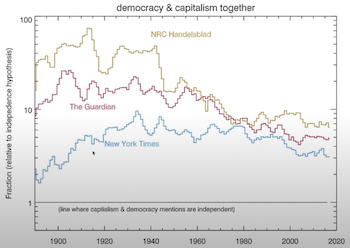-
-
Step-by-step course guide
-
What you will learn in this course
-
About the course: David Kinney & Simon DeDeo
-
Introducing the course Teaching Assistant
-
Join the discussion
-
Calendar & Deadlines
-
-
-
Introduction to Humanities Analytics
-
-
-
-
Analyzing "Excellence" in the Humanities
-
-
-
-
-
-
Case Study: Capitalism & Democracy
-
Chapter 5 part I Overview
-
The Marriage of Capitalism & Democracy part 1
-
Test Your Knowledge part 1
-
Test Your Knowledge part 1: Explanations
-
Chapter 5 part 2 Overview
-
The Marriage of Capitalism & Democracy part 2
-
Test Your Knowledge part 2
-
Test Your Knowledge part 2: Explanations
-
Assignment: Case Study: Capitalism & Democracy
-
-
-
-
-
Measurement & Operationalization
-
-
-
A Philosophical Approach to Probability
-
-
-
Guest Lecture: Marco Buongiorno Nardelli
-
-
-
-
Getting Started with Scientific Programming
-
-
-
Application: Blurbs, the Culture Industry & the Uses of Literature
-
Final Assignment
-
-
-
Guest Lecture: Nan Z. Da
-
-
-
Wrap-Up
-
What's Next
-
8.1 Case Study: Capitalism & Democracy » Test Your Knowledge part 2: Explanations
Q1. Over the time period presented in the lecture, which newspaper tended to show the greatest linkage between "capitalism" and "democracy"?
 A. NRC Handelsblad
A. NRC Handelsblad
B. The New York Times
C. The Guardian
D. The newspapers are all equivalent.
Correct answer: (A). By contrast, The New York Times (B) was barely linking capitalism and democracy in the early years of study, whereas The Guardian (C) showed middling levels of linkage. While all three newspapers converge to similar levels of linkage between capitalism and democracy over the course of the 20th century, the Dutch newspaper Handelsblad consistently shows the highest level of linkage over the entire time period (with a short-lived exception around 1964).
Q2. According to a null model in which there is no linkage between capitalism and democracy, how often would we expect to find the words "capitalism" and "democracy" in the same article?
A. We would never expect to find them in the same article.
B. We would expect the frequency of articles containing both "capitalism" and "democracy" to be equal to the product of the frequency of articles containing "capitalism" and the frequency of articles containing "democracy."
C. We would expect to see any article mentioning "capitalism" to also contain the word "democracy."
D. We would expect to see any article mentioning "democracy" to also contain the word "capitalism."
Correct answer: (B). According to a null model, whether or not an article discusses "capitalism" has no bearing on whether it discusses "democracy", and vice versa. This does not mean that we would never expect to see the words together. Instead, it means that where the words do appear together, this happens by chance, like two fair coin tosses both landing on the same side. In probability theory, when two events are independent, the probability of their co-occurence is equal to the product of the probability that one occurs and the probability that the other occurs. For the coin toss, the probability of two heads is P(Heads) x P(Heads) = 0.5 x 0.5 = 0.25.
Q3. The linkage between "capitalism" and "democracy" converges to a relatively low level beginning around 1979 across the three newspapers. Which of the following is posited in the lecture as an explanation for the convergence?
A. The Soviet invasion of Afghanistan.
B. The beginning of personal computing.
C. The emergence of the neoliberal order in Western democracies.
D. The release of The Clash's seminal album London Calling.
Correct answer: (C). Simon cites Christian Caryl's Strange Rebels as highlighting the year 1979 as a turning point in Western democracies, in which the rise of free-market capitalism emerged as an end unto itself, without any explicit linkage to democracy or other social virtues. See the lecture discussion [17:58].
